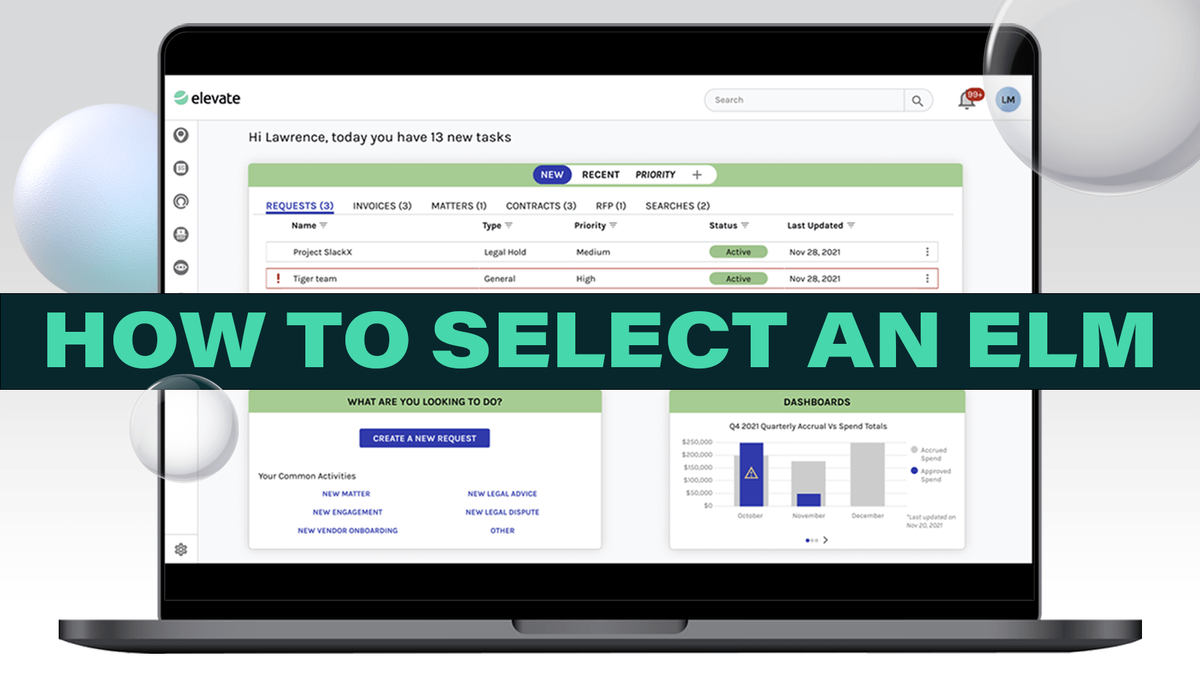Ten Key Questions to Ask When Choosing an ELM
February 16, 2022
A complete ELM (Enterprise Legal Management) system has long been promised since the idea’s introduction in the 1990s. But to have a real solution – a fully developed ELM – many components must work and play well with others. Not just within their own systems but also in integrating with others. Today, many companies tout what they claim is a total solution, but before you go down the purchasing path, there are several important considerations in selecting the right solution for you and your team.
Do you have a clear understanding of your needs?
This is a foundational question; answering it thoughtfully and thoroughly at the outset is critical to the ultimate success of selecting an ELM. Without a comprehensive and well thought out needs assessment, you are likely to get run over by a vendor who claims that what you need is – lo and behold! – precisely what their system does. Or, you may waste time and resources over-engineering the system or selecting one for the wrong reasons. First, identify the pain points you seek to eliminate and then pick an ELM that fits your specific needs, rather than thinking that whatever a particular ELM does must be precisely what you need.
What can you fix before selecting an ELM?
If your processes are inefficient or need updating, fix things before you start shopping for an ELM. You shouldn’t expect your new ELM to solve everything; the usefulness of an ELM’s functionality hinges on whether you have good processes in place that leverage that functionality.
Does it have all the functionality you need?
You will find suppliers touting they have a “complete” ELM solution when in reality, it only provides matter and spend management. A true ELM goes much further and provides a comprehensive picture, including managing requests, RFPs, contracts, spend, reporting, and analytics. With these functionalities housed on one platform, you can connect people and systems, gain efficiency, facilitate communication, and obtain data-driven insights required in today’s legal environment.
Is software all that you’re getting?
Many of the technology companies offering ELMs are just that – technology companies. Sure, they will help you install their solution and probably even have a customer success team to ensure their software is working correctly. But for anything beyond that, they partner with other companies not native to their technology. Practically speaking, buying from a technology company leaves you to tackle developing and executing a change management plan – a crucial aspect in deploying technology. Is your organisation prepared to create and carry out such a plan? Make sure that your technology partners have a holistic vision of what you are trying to accomplish by implementing an ELM platform. The success of any new technology depends on having a sound implementation plan.
Is it secure?
When it comes to where to situate technology, there are two schools of thought. On-site installations are where technology began, so many companies feel more secure having the responsibility and control over housing software themselves. There are risks – one significant vulnerability is dependence on individuals for the absolute security of your on-site systems. Make sure that your ELM is cloud-based. As technology has progressed, so has cloud security, to the point where cloud-based systems provide greater security than locally installed software. Be sure you understand where your cloud-based system is housed and its security capabilities – your system will need things like single sign-on, multi-factor authentication, and role-based access controls.
Does it integrate?
Many companies and firms have well-established solutions for billing, invoicing, matter management, and the like. What if you have solutions that work for you but are still missing critical pieces? You should not have to invest in a full ELM and start over from scratch. You need to ensure any ELM you purchase integrates with the legacy solutions you want to keep. It doesn’t have to be an all-or-nothing decision – if a vendor requires you to buy their entire enterprise solution, keep looking! A good ELM solution is modular and integrates easily into existing solutions while filling any technological gaps to provide a complete legal operations solution.
Do you have dedicated customer support services? For how long?
Today, many technology companies provide customer support services once you have purchased their technology. But how long does this last? Make sure the company you purchase from is committed to you beyond the purchase or implementation. They should ensure that their technology serves you well beyond implementation. And make sure that the company provides an individual responsible for the quality of their customer support to you. Ideally, that person establishes how you define success for using the new technology and then provides a path towards those goals. If the company’s standard operating procedure doesn’t include regular meetings to ensure customer support is running well, that’s a red flag.
How is it built?
If an ELM is to truly be seamless, the technology behind it is critical. This is especially true because many ELM technology companies, when unable to build solutions to fill the technological gaps in their offerings, purchased different point solutions to fill those gaps. This enabled them to get to market faster, but it resulted in a jarring user experience, particularly in trying to do work across one application to another. Adoption suffered as a result. Moreover, it was impossible to get a complete view of data across these patchworks of applications. Siloed data is already a problem for many law departments and organisations; picking a solution that doesn’t solve this issue only exacerbates the problem. A thoughtfully-built ELM platform with a design incorporating insight from legal industry users aids adoption, and because, by design, it combines data throughout the ELM into one reporting module, it meets the need for fully informed, data-driven insights.
Is the ELM customisable?
Customisability is a double-edged sword. Highly customisable ELMs let you address unique requirements more common in large law organisations. But customisable ELMs cost more and take more time to deploy. For smaller companies or firms, customisation may not be worth it; a “hard-wired” ELM that works out-of-the-box may suffice. For companies and firms in the middle, such as a regional firm or an international company in a growth phase, the best solution may be a “hybrid” ELM that works off the shelf but is sufficiently configurable to meet your needs.
Is there a preferred entry point?
For the people responsible for legal operations, the requests that flow into the law department can be tough to manage using email and a spreadsheet. Ideally, there is a single entry point for all requests processed through the integrated ELM. Sound request management provides insight into the volume of requests, the rate they are handled, and other valuable metrics – making request management a preferred place to begin your ELM implementation experience.
Summary
There are a lot of good technology solutions out there, from enterprise behemoths to smaller, niche solutions. Either end of that spectrum may work for your organisation, whether a law department or law firm. If you require either a nimble enterprise solution or a robust speciality solution, make sure you obtain answers to the questions above – before you invest the money, time, and resources necessary for a successful implementation. Once you implement the ELM solution that’s right for your circumstances, you will enjoy increased productivity, greater insights, and better collaboration.
Back to Expertise


 Allison Hart
Allison Hart